Ghoonghat
A ghoonghat (ghunghat, ghunghta, ghomta, orhni, odani, laaj, chunari, jhund, kundh) is a headcovering or headscarf, worn primarily in the Indian subcontinent, by some married Hindu, Jain, and Sikh women to cover their heads, and often their faces.[1][2] Generally aanchal or pallu, the loose end of a sari is pulled over the head and face to act as a ghoonghat. A dupatta (long scarf) is also commonly used as a ghoongat.[3]
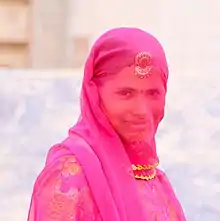
Since the ancient period of India, certain veiling practices (what became known as ghoonghat) has been partially practiced among a section of women.[4][5] However, it is notable that some section of society from the 1st century B.C. advocated the use of the veil for married women. There is no proof that a large section of society observed strict veiling until the medieval period.[6] This process mostly established in the current form after the arrival of Islam in the subcontinent.[7] Today, facial veiling by Hindu women as part of everyday attire is now mostly limited to the Hindi Belt region of India,[8][9] particularly Haryana, Uttarakhand, Rajasthan, Himachal Pradesh, Delhi, Uttar Pradesh, Madhya Pradesh, Gujarat, Bihar, and some parts of Sindh and Punjab.[3]
It has been both romanticized and criticized in religious and folk literature.[10]
Etymology
The word ghoongat, ghunghat or ghunghta is derived from Avagunthana (Sanskrit: अवगुण्ठन) meaning veil, hiding and cloak and Oguntheti (Prakrit: ओगुन्थेति) to cover, veil over and hide. [11] [12]
History
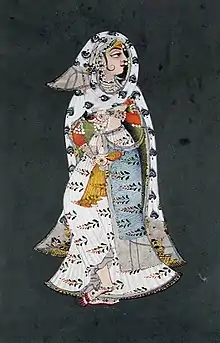
The ghoongat, ghunghat or ghunghta veil evolved from ancient Avagunthana in (Sanskrit: अवगुण्ठन) veil, hiding and cloak.[13] Early Sanskrit literature has a wide vocabulary of terms for the veils used by women, such as avagunthana meaning cloak-veil, uttariya meaning shoulder-veil, adhikantha pata meaning neck-veil, and sirovas-tra meaning head-veil.[14][15]
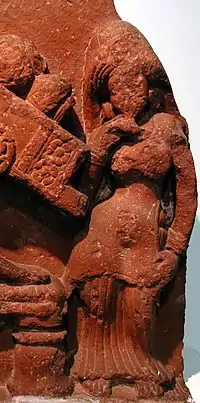
In the post-Gupta period, Śūdraka, the author of Mṛcchakatika mentions that some females wore a veil (avagunthana). However, this female hair-dress was not used by women every day and at every time. It was worn on special occasions like marriage or at the time of going out. Śūdraka notes that a married woman was expected to put on a veil while moving in the public. This may indicate that it was not necessary for unmarried females to put on a veil.[16]
In Mṛcchakatika, courtesan Vasantasena's mother, having received ornaments for her daughter from a wealthy suitor to keep her as his mistress, she sends Vasantasena with her maid, asks her to go in the carriage bedecked with ornaments and to put on her avagunthana veil. This instruction is taken to signify that a courtesan who has accepted a suitor, had to use a veil in public similar to married women.[17] At the end of the play when Vasanthasena is legally wedded, she receives the title "Vadhūśabda" meaning "title of a bride" simultaneously with the veil "vasantasenām avagunthya" meaning "a token of honorable marriage".[18] In the same literature, courtesans' maid servant Madanika marries her lover Sarvilaka, a thief who changes his ways. Her new husband says to her that she has achieved what is difficult to acquire: "Vadhūśabda avagunthanam" meaning "the title and veil of a bride".[19]
In the Pratimānātaka, a play by Bhāsa (3 - 4 CE) describes in context of the Avagunthana cloak-veil that "ladies may be seen without any blame [for the parties concerned] in a religious session, in marriage festivities, during a calamity and in a forest".[20] The same sentiment is more generically expressed in Nāgānanda and Priyadarśikā by Harsha, where maidens were expected to wear no veil; it was donned only after the marriage.[21] Later, the veil was referred to by the same term, avagunthana, in Śiśupālavadha and the Dashakumaracharita.[22] According to commentator Sankara, the ladies of Sthanvisvara used to go about covering their faces with a veil.[23]
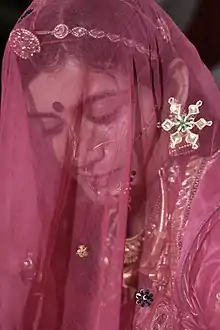
In Buddhist Mahayana literature, Lalitavistara Sūtra, young bride Yasodharā objected to observe veiling (oguntheti/oguṇthikā) in front of respected elders. This was taken to be a sign of immodesty and willfulness, as people criticized her and gossiped.[24] When she became aware of this, Yasodharā came before the assembled court and defended herself in a long statement: "Those whose thoughts have no cover, no shame or decorum or any virtue, those who gossip, may cover themselves with a thousand garments, yet they walk the earth naked. But those who veil their minds, control their senses, and have no thought for any other except their husband, why should they veil their faces?" Yasodharā's parents-in-law were delighted with their daughter-in-law's proud statement and gave her two white garments covered with jewels.[25]
The Lalitavistara Sūtra reflects changing times around the 3rd century CE and Buddhists' attempt to counter this growing practice, as there is no mention of this entire incident in early Buddhist Theravada literature.[26][27]
In Valmiki's Ramayana dated between the 5th century BCE to the 3rd century CE, Prince Rama asks his wife Sita to unveil herself so that the gathered citizens of Ayodhya can take a look at them before they go in exile to the forest; there is no mention of Sita veiling herself again after this incident.[28] At the end of the epic, hearing the news of Ravana's death, his queens giving up to lamentations rush outside without their Avagunthana, in which chief queen Mandodari surrounding his corpse says "Why do you not get angry, beholding me, having put off my veil, walk out on foot by the city gate? Do you behold your wives who have thrown off their veils. Why are you not angry seeing them all come out of the city?"[29] Thus, it is notable that royal women avoided public gaze and veiling was expected to be worn only by married women.[30]
In Abhijñānaśākuntalam by Kālidāsa, written between the 3rd and 4th century CE, when the heroine arrives at King Duhsanta's palace, seeking to take up her wifely status, the king first remarks "Kā svid avagunthanavati" meaning "who is this veiled one?" and immediately forbears to look at her, with the words "Anirvarnaniyam parakalatram" meaning "The wife of another is not to be inspected."[31] This largely indicates that Avagunthana was a sign of a respectable married woman, and was a married woman's raiment.[32]
Medieval period
In Kathāsaritsāgara written in the 11th century AD, heroine in the story Ratnaprabhā protesting: "I consider that the strict seclusion of women is a folly produced by jealousy. It is of no use whatsoever. Women of good character are guarded only by their own virtue and nothing else."[33] Rational opposition against veiling and seclusion from spirited ladies resulted in the system not becoming popular for several centuries.[34] However, it is notable that some section of society from the 1st century B.C. advocated the use of the veil for married women. There is no proof that a large section of society observed strict veiling until the medieval period.[6]
Under the Islamic Mughal Empire, various aspects of veiling and seclusion of women was adopted, such as the concept of Purdah and Zenana, partly as an additional protection for women.[35] Purdah became common in the 15th and 16th century, as both Vidyāpati and Chaitanya mention it.[36] Sikhism was highly critical of purdah; Guru Amar Das condemned it and rejected seclusion and veiling of women, which saw decline of purdah among most classes during this period.[37]
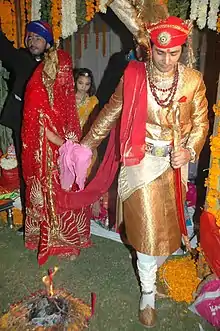
Significance
In ghoonghat practice, facial veiling observed by married women is known as Laaj (Sanskrit: लज्जा, Lajja - modesty, honor, shame). In veiling practice, it literally means "To keep (one's) modesty, shame and honor". Earliest attested word Laaj in context of veiling is found in Valmiki's Ramayana as lajjaavaguNThanaan describing Mandodari.[29] However, it is unclear whether it refers to facial veiling.[38]
During a marriage ceremony, the bride wears a veil given by her parents. Later, during the ceremony the bride's mother-in-law covers her face with ghoonghat; she therefore simultaneously wears the veil given by her parents and that from her in-laws, symbolizing her passing from the protection of one's household to another.[39]
Muh Dikhai (Devanagari: मूह दिखाई, first gaze) is a post-wedding ceremony, where the bride is formally introduced to the groom's relatives and extended family. The ceremony takes place once the bride arrives in her new home; each family member lifts her veil, looks at the bride and gives her a welcoming gift. She receives Shagun from her mother-in-law, which is typically jewelry, clothing and silverware. After this ceremony the bride observes full veiling for the next few months or until her parents-in-law advise her to unveil.[40]
Post-1900s
During the early 1900s, women of royal and aristocratic class were first to abandon strict veiling in public. However, the head was loosely veiled due to sensitivity towards the custom during changing times.[41] The other classes soon followed; it lingered on in some parts of India until well after the 1940s. Facial veiling has gradually declined, and is mostly limited to parts of Hindi-speaking areas today.[42] In ghungat, a woman will veil her face from all men to whom she's related by marriage who are senior to her husband. The effect of ghungat is to limit a young woman's interaction with older men.[43][44]
In 2004, the India Human Development Survey (IHDS) found that 55% of women in India practice some form of ghoonghat, majority of them in Hindi-speaking states.[45] The survey found that some women may cover their face fully but for others, partial covering of the face is more a nod to propriety than a large impediment.[46] Dupatta is a part of Punjabi suit which is traditionally worn by the Sikh women. While old Sikh women always cover their heads with it, the younger women prefer to put it around their shoulders.[47] Women are supposed to cover their heads with dupatta or chunni in gurdwaras.[48]
Gallery
 Bride in veiling during Muh Dikhai ceremony.
Bride in veiling during Muh Dikhai ceremony.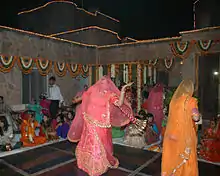 Women in veil performing folk dance at wedding.
Women in veil performing folk dance at wedding. Woman performing folk dance in ghoonghat.
Woman performing folk dance in ghoonghat. Woman with a ghoonghat performing a Ghumar dance.
Woman with a ghoonghat performing a Ghumar dance.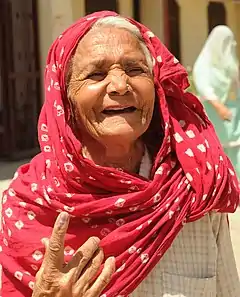 Old woman in Haryana with odhni
Old woman in Haryana with odhni
References
- Gupta, Kamala (2003). Women In Hindu Social System (1206–1707 A.D.). Inter-India Publications. ISBN 9788121004145.
Hindu ladies covered their head with a kind of veil known as Ghoonghat.
- Gupta, Kamala (1987). Social Status of Hindu Women in Northern India, 1206-1707 A.D. Inter-India Publications. p. 131. ISBN 978-81-210-0179-3.
The Hindu ladies covered their heads with a kind of veil known as ghoonghat.
- Spurgeon, Andrew B. (14 August 2016). Twin Cultures Separated by Centuries: An Indian Reading of 1 Corinthians. Langham Publishing. p. 196. ISBN 978-1-78368-139-6.
Ghoonghat (also ghunghat or jhund) is the Hindi word used for a veil or a scarf that a woman in northern India wears to cover her head or face (in states such as Gujarat, Rajasthan, Haryana, Bihar, Uttar Pradesh, and Assam). Sometimes the end of a sari or dupatta (a long scarf) is pulled over the head or face to function as a ghoonghat.
- Srivastava, Ashok Kumar (1967). India as Described by the Arab Travellers. Sahitya Sansar Prakashan.
...there was partial exclusion of women in Ancient India and women observed a curtain or 'Veil,' the so called 'Ghoonghat' of the modern times.
- Kant, Anjani (2003). Women and the Law. APH Publishing. p. 53. ISBN 978-81-7648-456-5.
...even in ancient India there was a partial exclusion of women and they observed a curtain veil (or what even now goes under the name of ghoonghat).
- Anant Sadashiv Altekar (1959) "The Position of Women in Hindu Civilization.", p.174
- Walsh, Judith E. (2006). A Brief History of India. Infobase Publishing. p. 88. ISBN 9781438108254.
Ancient Indian society had also developed practices that restricted women's social mobility and behavior, particularly in the early centuries A.D. Over the centuries in which Muslims ruled many sections of India, Muslim conventions intensified these Hindu practices, and by the 19th century purdah was the customary practice of high-caste Hindu and elite communities throughout India.
- Raj Mohini Sethi (2011) "Socio-economic Profile of Rural India (series II).", p.111
- IHDS 2004–5 data "Gender and Family Dynamics.", p.153
- Anant Sadashiv Altekar (1959) "The Position of Women in Hindu Civilization.", p.171
- "Sanskrit - Dictionary".
- Ambalaṅgoḍa Polvattē Buddhadatta, A. P. (1957) "Concise Pāli-English Dictionary.", p.69
- "Sanskrit - Dictionary".
- Govind Sadashiv Ghurye (1951) "Indian Costume.", p.236
- Ramesh Prasad Mohapatra (1992) "Fashion Styles of Ancient India: A Study of Kalinga from Earliest Times to Sixteenth Century AD", p.24
- Sulochana Ayyar (1987) "Costumes and Ornaments as Depicted in the Sculptures of Gwalior Museum.", p.152
- Govind Sadashiv Ghurye (1951) "Indian Costume.", p.236
- Laurie Patton (1961) "Jewels of Authority: Women and Textual Tradition in Hindu India.", p.81
- Laurie Patton (1961) "Jewels of Authority: Women and Textual Tradition in Hindu India.", p.81
- Govind Sadashiv Ghurye (1951) "Indian Costume.", p.236
- Anant Sadashiv Altekar (1959) "The Position of Women in Hindu Civilization", p.170
- Sulochana Ayyar (1987) "Costumes and Ornaments as Depicted in the Sculptures of Gwalior Museum.", p.152
- Govind Sadashiv Ghurye (1951) "Indian Costume.", p.239
- Betty Kelen 1967 "Gautama Buddha: In Life and Legend" chapter 1, pp. 7 and 8
- Betty Kelen 1967 "Gautama Buddha: In Life and Legend" chapter 1, pp. 7 and 8
- Betty Kelen 1967 "Gautama Buddha: In Life and Legend" chapter 1, pp. 7 and 8
- Rohini Chowdhury 2011 "Gautama Buddha: The Lord of Wisdom" chapter 1, page 9.
- Anjani Kant (1951) "Women and the Law.", p.43
- Valmiki Ramanaya, chapter 111 - stanza 6-111-63 and 6-111-64
- Anjani Kant (1951) "Women and the Law.", p.43
- Laurie Patton (1961) "Jewels of Authority: Women and Textual Tradition in Hindu India.", p.81
- Laurie Patton (1961) "Jewels of Authority: Women and Textual Tradition in Hindu India.", p.81
- Anant Sadashiv Altekar (1959) "The Position of Women in Hindu Civilization.", p.173
- Anant Sadashiv Altekar (1959) "The Position of Women in Hindu Civilization.", p.171
- Anant Sadashiv Altekar (1959) "The Position of Women in Hindu Civilization.", p.175
- Anant Sadashiv Altekar (1959) "The Position of Women in Hindu Civilization.", p.175
- Dhillon, Dr Jaswant Singh (21 February 2023). Comparative Study Of World Religions. Christian Faith Publishing, Inc. p. 84. ISBN 978-1-68517-435-4.
- Anjani Kant (1951) "Women and the Law.", p.43
- Emma Tarlo 1996 "Clothing Matters: Dress and Identity in India", p.177
- Doranne Jacobson, Susan Snow Wadley 1999 "Women in India: two perspectives", p.195
- Laurie Patton (2004) "Maharanis: The Lives and Times of Three Generations of Indian Princesses.", p.81
- Raj Mohini Sethi (2011) "Socio-economic Profile of Rural India (series II).", p.111
- Guindi, Fadwa El (2003). Veil: modesty, privacy and resistance (Repr. ed.). Oxford [u.a.]: Berg. pp. 109–111. ISBN 1859739296.
- Nevile, Pran (2006). Lahore: a sentimental journey. New Delhi, India: Penguin Books. p. 77. ISBN 0143061976.
- IHDS 2004–5 data "Gender and Family Dynamics.", p.153
- IHDS 2004–5 data "Gender and Family Dynamics.", p.153
- S.K. Rait (2005). Sikh Women in England: Their religious and cultural beliefs and Social practices. Trentham Books. ISBN 9781858563534.
- Devendra Singh (2009). Beyond Boundaries : A Search for Unlimited Powers of Mind Along the Path... Hemkunt Press. p. 133. ISBN 9788170103813.